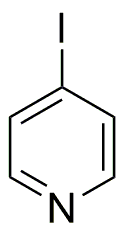4-Iodopyridine is widely utilized in research focused on:
- Synthesis of Pharmaceuticals: This compound serves as an important building block in the synthesis of various pharmaceutical agents, particularly in the development of antiviral and anticancer drugs.
- Organic Electronics: It is used in the fabrication of organic semiconductors, which are crucial for developing flexible electronic devices, such as organic light-emitting diodes (OLEDs) and organic solar cells.
- Catalysis: 4-Iodopyridine acts as a ligand in transition metal-catalyzed reactions, enhancing the efficiency and selectivity of chemical transformations in organic synthesis.
- Research in Material Science: The compound is employed in the creation of functionalized materials, contributing to advancements in nanotechnology and materials engineering.
- Bioconjugation: It is utilized in bioconjugation techniques, facilitating the attachment of biomolecules to surfaces or other molecules, which is essential in drug delivery systems and diagnostic applications.
General Information
Properties
Safety and Regulations
Applications
4-Iodopyridine is widely utilized in research focused on:
- Synthesis of Pharmaceuticals: This compound serves as an important building block in the synthesis of various pharmaceutical agents, particularly in the development of antiviral and anticancer drugs.
- Organic Electronics: It is used in the fabrication of organic semiconductors, which are crucial for developing flexible electronic devices, such as organic light-emitting diodes (OLEDs) and organic solar cells.
- Catalysis: 4-Iodopyridine acts as a ligand in transition metal-catalyzed reactions, enhancing the efficiency and selectivity of chemical transformations in organic synthesis.
- Research in Material Science: The compound is employed in the creation of functionalized materials, contributing to advancements in nanotechnology and materials engineering.
- Bioconjugation: It is utilized in bioconjugation techniques, facilitating the attachment of biomolecules to surfaces or other molecules, which is essential in drug delivery systems and diagnostic applications.
Documents
Safety Data Sheets (SDS)
The SDS provides comprehensive safety information on handling, storage, and disposal of the product.
Product Specification (PS)
The PS provides a comprehensive breakdown of the product’s properties, including chemical composition, physical state, purity, and storage requirements. It also details acceptable quality ranges and the product's intended applications.
Certificates of Analysis (COA)
Search for Certificates of Analysis (COA) by entering the products Lot Number. Lot and Batch Numbers can be found on a product’s label following the words ‘Lot’ or ‘Batch’.
*Catalog Number
*Lot Number
Certificates Of Origin (COO)
This COO confirms the country where the product was manufactured, and also details the materials and components used in it and whether it is derived from natural, synthetic, or other specific sources. This certificate may be required for customs, trade, and regulatory compliance.
*Catalog Number
*Lot Number
Safety Data Sheets (SDS)
The SDS provides comprehensive safety information on handling, storage, and disposal of the product.
DownloadProduct Specification (PS)
The PS provides a comprehensive breakdown of the product’s properties, including chemical composition, physical state, purity, and storage requirements. It also details acceptable quality ranges and the product's intended applications.
DownloadCertificates of Analysis (COA)
Search for Certificates of Analysis (COA) by entering the products Lot Number. Lot and Batch Numbers can be found on a product’s label following the words ‘Lot’ or ‘Batch’.
*Catalog Number
*Lot Number
Certificates Of Origin (COO)
This COO confirms the country where the product was manufactured, and also details the materials and components used in it and whether it is derived from natural, synthetic, or other specific sources. This certificate may be required for customs, trade, and regulatory compliance.


